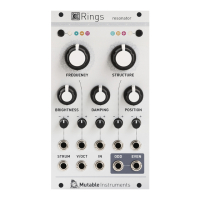A. Polyphony setting. Selects between monophonic, duophonic and quadriphonic operation.
B. Resonator type. Selects between modal, sympathetic and string resonators.
C. Coarse frequency, adjusted by semitone increments. This control spans 5 octaves.
D. Harmonic structure. With the modal resonator, this parameter controls the frequency ratio between
partials (and by doing so, the perceived structure - plate, bar, string). With the sympathetic string
resonator, this parameter controls the set of frequency ratios between all strings (with virtual notches at
octaves or fifths). Finally, with the modulated/inharmonic string resonator, this parameter controls the
amount of modulation and detuning of the partials.
E. Brightness. Adjusts the level of higher harmonics in the signal, by the simultaneous action of a low-
pass filter on the exciter signal (closed at 8 o’clock, fully open at 12 o’clock), and the damping filter (or Q
factor of the higher modes) on the rest of the course of the potentiometer. Low values simulate materials
like wood or nylon. High values simulate materials like glass or steel.
F. Damping. Controls the decay time of the sound, from less than 100ms to about 10s.
G. Excitation position. Controls on which point of the string/surface the excitation is applied. Applying
the excitation right in the middle of the surface will cause, by symmetry, the even harmonics to cancel
each other, resulting in a “hollow” sound reminiscent of a square wave. This setting will remind you of the
PWM control on a square oscillator – or of the comb-filtering effect of a phaser.
H. Attenuverters for the CV inputs.
1. Resonator parameters CV inputs. Note that the FREQUENCY CV input is normalized to a
1
⁄
12
V
voltage, allowing its attenuverter to be used as a fine frequency control when no patch cable is inserted.
2. Strumming trigger input, for polyphonic operation. Whenever a trigger is received on this input, the
module freezes the currently playing voice and lets it decay, and starts a note on the next voice.
Normalized to a step detector on the V/OCT input and a transient detector on the IN input.
3. V/oct CV input. Controls the main frequency of the resonator.
4. Audio INPUT for the excitation signal. Modular levels are expected! Normalized to a pulse/burst
generator that reacts to note changes on the V/OCT input.
5. Odd and even audio outputs. In monophonic mode, these two outputs carries two complementary
components of the signal (odd and even numbered partials with the modal resonator, dephased
components due to picking position and pickup placement with the string resonators). In polyphonic mode,
splits the signal into odd and even numbered strings/plates. Note that you need to insert a jack into each
output to split the signals: when only one jack is inserted, both signals are mixed together.

